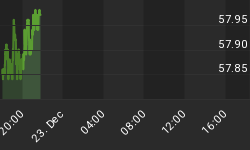In this series, I am going to be writing about basics of of Elliott Wave (EW). I want to keep this as simple as possible, because it is simple. The other objective I have for this series, is to make it relevant to trading. This is not for the academician, this is for the trader.
I will examine how EW analysis can be used to project turning points in the market. In order to quantify these turning points (swing highs and lows), we will need to understand fibonacci numbers and how they are used in EW analysis.
I won't bore 90% of you with an essay on Fibonacci numbers. By definition, the first two Fibonacci numbers are 0 & 1. The remaining numbers are the sum of the previous two numbers. So it looks like this ~ 0, 1, 1, 2, 3, 5, 8, 13, 21, 34, 55, 89, 144 … and so on. Traders have converted these Fib numbers into percentages by methods we won't go into here. Common Fibonacci derived percentages that you will see used by traders are 23.6%, 38.2%, 61.8%, 127.2%, 161.8% and 261.8%. Non-Fibonacci derived numbers that are also commonly used are 50% and 78.6%. These percentages are applied to technical analysis (TA) in several ways: retracements, extensions, fans, arcs and time studies.
It's the ratio of the numbers in the Fibonacci sequence that is significant to most traders, but actual Fibonacci numbers are also used. The one number that get's Fibonacci devotees excited is 1.618 or its inverse .618. This proportion is known as the golden ratio, the divine proportion or PHI. It is derived by dividing a Fibonacci number by the number preceding it in the sequence. Some traders will tell you that the markets follow the proportions of the Fibonacci numbers because these ratios define human behavior and therefore market action. Fortunately, you don't have to drink that Kool-Aid to believe in the power of Fibonacci numbers in technical analysis. When thousands of traders make trading decisions based on Fibonacci-derived levels on a chart, you will see market action be influenced by these levels. In a strong bull or bear market, you may only see a consolidation it the market isn't ready for a reversal. Are Fibonacci support and resistance levels self-fulfilling prophecies? What difference does it make? They work!
You will notice that Wave 1 and Wave A are discussed together. That is because they often can't be correctly labeled and distinguished until after the market unfolds and W3 or Wave C have progressed.
W1 Pattern: Five waves (uncommonly a leading diagonal) * TIP: if W1 is a leading diagonal expect W3 to be extended.
Wave A Pattern: Usually five waves (uncommonly a leading diagonal), but can be three. Why might you want to estimate the end of W1? Let's say you just nailed the end of a W5 or Wave C and are long with a great entry. There are two things that I would expect to happen. First, if this turns out to be a W1 or Wave A, you can expect a retracement from 50-78.6%. That could be a lot of profit that you potentially are giving back. Especially since, at the time, you're not even certain that you nailed the swing high or low and might get stopped out for a net loss. I will often project the end of the Wave 1/A and take my profits. I'll then wait to reenter at the end of Wave 2/B. Or, another money management technique might be to close 1/2 my position, and put a break-even stop on the rest. I can then reenter the other half-position at the end of W2/B. My decision would probably be based on how many points we are talking about with the swings I'm trading.
So, what do I look for to give me an indication that W1 or A is about to end? If I am trading a 3 min. chart, I might have time to run some retracements on prior swings. If I am using different swings, the Fibonacci retracements (38.2%, 50%, 61.8%, and 78.6%) from multiple swings might coincide to give me a hint. Usually, at the end of a swing, the 15 EMA is still sloping steeply in the direction of the former trend. I often find that this moving average will provide resistance and end the wave. The other consideration that we always must factor into our projection is pattern completion. Since it is possible that this is a Wave A with a 3 wave structure, I wouldn't begin looking for the end of the wave until three waves of lesser degree are complete.
Below is an illustration that may clarify what I'm saying. This is a very generic illustration of wave patterns that I often see at the end of a trend or large correction. The magnitude of the swings that we are looking at will dictate whether we would even be taking these trades. You'll notice that I don't have a price scale on this illustration. Assume that this is a 15 to 60 min. chart with large swings. That would make the identification of the end of this wave very significant.

There are other trading considerations that we will cover in later posts, but that is a very general overview of my approach to projecting the end of Wave 1 and A. I will add a chart that will illustrate these points when I find a representative one. My next lesson will discuss Wave 2 or B.
If you like what you see here, wait to see how MortiES's analysis can assist you in your everyday investing or trading strategy! Go ahead. Click on "Subscribe to MortiES Premium" and give it a try! I am offering a 30 day free trial period.
















